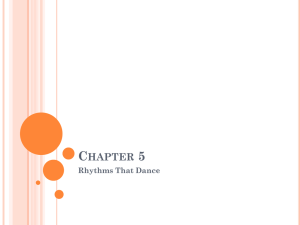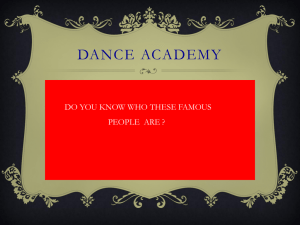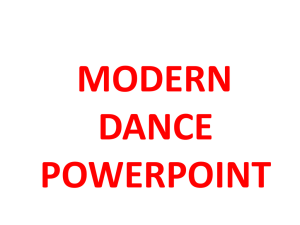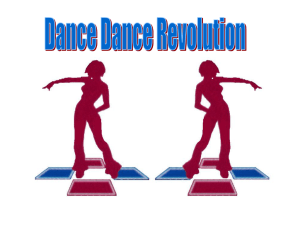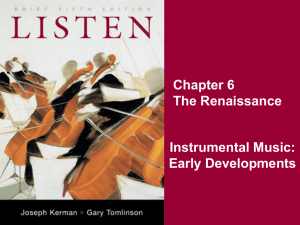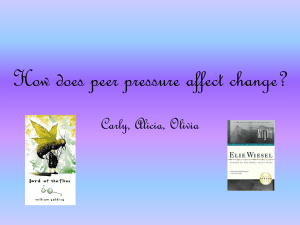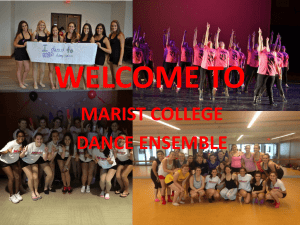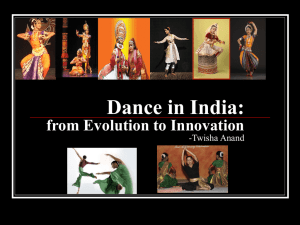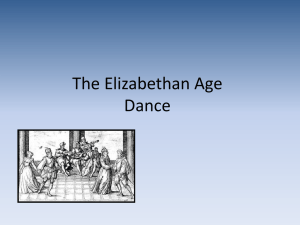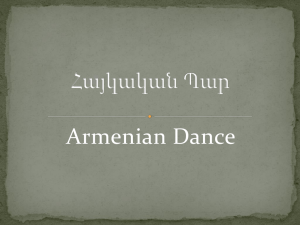Chapter 5 Power Point - Petal School District
advertisement
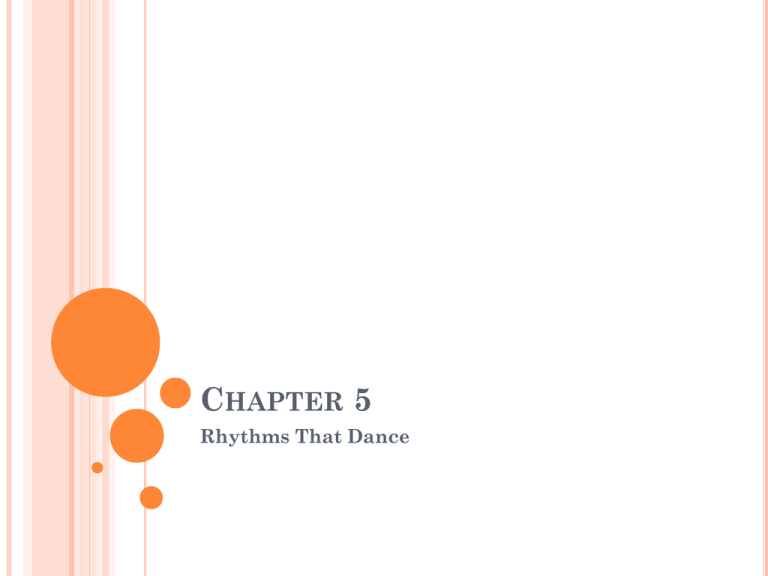
CHAPTER 5 Rhythms That Dance EARLY AMERICAN INFLUENCES Native American developed a rich tradition of dance to serve social, ceremonial, and spiritual purposes. American dance traditions can be traced to European and African roots. EUROPEAN INFLUENCES Reels – Irish dances from a word meaning “a weaving motion”, danced to quick music in duple meter, for 2-16 dancers, forerunners of square dancing Jigs – Irish dances that use music in 6/8 time with a triple meter, name refers to the dancers up and down movement Ceili (kay-lee) – includes mainly reels and jigs, a traditional Irish or Scottish social dance. Some of the reels and jigs were forerunners to CLOGGING – 1994 – Riverdance became popular, combined traditional step dancing with contemporary music and costumes. https://www.youtube.com/watch?v=w8EXDtoGfrs CONJUNTO Conjunto – a dance music created by Mexicans in Texas, influenced by European neighbors it includes polka sounds with traditional Mexican sounds. https://www.youtube.com/watch?v=pCjLTXVCd1s HULA Film industry grew popular in Hawaii in the 1930s (before it became a state in 1959). The hula was seen as superficial entertainment, but now provides links to Hawaii’s past. Hula means movement and gestures. Ukulele – small 4 stringed guitar, used to accompany the hula The hula can be performed standing or seated. https://www.youtube.com/watch?v=l_WmLl9p_MM https://www.youtube.com/watch?v=s9dof5o64H8 CLASSICAL DANCE https://www.youtube.com/watch?v=CcC6ISw-dEs Ballet – refined style of classical dance emphasizes the verticality of the body, an outward rotation of the legs with fluid foot and leg work, and virtuosic turns and jumps Ballet emerged from Italy and France during the 16th century. It has roots in European court dances. Popular ballets – Swan Lake, Sleeping Beauty, The Nutcracker https://www.youtube.com/watch?v=Wz_f9B4pPtg https://www.youtube.com/watch?v=DOARfu8modE BALLET BREAKS NEW GROUND 1913 – Popular choreographer Vaslav Nijinsky worked on a ballet, The Rite of Spring – by Russian Igor Stravinsky. Nijinsky’s choreo broke established rules of classical ballet. The dancers’ legs were bent and turned in; their movements were heavy. A riot broke out – people threw whatever was handy at the musicians and dancers: food, programs, and items of clothing. It was only danced 7 times with the original choreography. https://www.youtube.com/watch?v=d6d8wacBjPQ WEST SIDE STORY Dance found its way to broadway musicals through Operettas and Vaudeville shows. In West Side Story the dances are memorable because they are integral to the story. It opened on Broadway in 1957 as a modern-day version of Romeo and Juliet. The music is by composer Leonard Bernstein who, for the musical/movie, carefully blended Latin American dance rhythms with American jazz. Mambo – a type of ballroom dance that originated in Cuba https://www.youtube.com/watch?v=kokbJvSEMUY Cha-cha – a rhythmic Latin American dance with the basic pattern of three steps and a shuffle https://www.youtube.com/watch?v=FXNZFe63brY Charleston – an athletic dance that includes kicks and inward leg rotations on syncopated beats of the music. Tap dancing – step dancing in which foot movements produce audible rhythms emphasized by small metal plates on the soles of the dancer’s shoes Bill “Bojangles” Robinson Savion Glover Lindy Hop – a jazzy dance where couples swing, balance, and twirl, featured “the breakaway” Tango – a Latin American dance performed at a moderately slow, walk-like tempo in 4/4 meter Samba – African-Brazilian dance that is faster and jazzier than the tango Rock and Roll – musical blend of rhythm and blues, country, and gospel styles The Twist – a dance and song by Chubby Checker Disco – electric mix of rhythm and blues, gospel, soul and Latin dance music; short for discotheque – meant music library Developed a need for DJs
